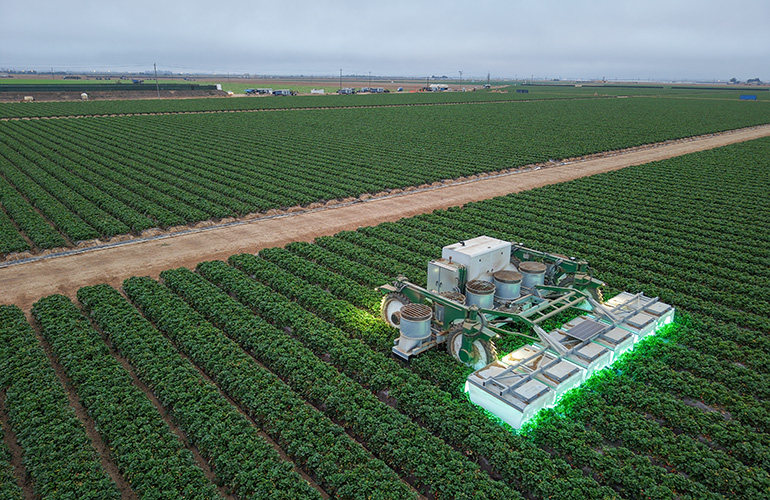
Ultraviolet light destroys pests and pathogens; the vacuum removes bugs — both chemical-free. | Credit: TRIC Robotics
TRIC Robotics, which focuses on autonomous pest and plant disease control, has secured $5.5 million in seed funding. The company plans to scale its autonomous robots for specialty crop farming, starting with strawberries—one of the most labor-intensive and pesticide-reliant crops.
“We have made incredible progress, with our fleet of robots reducing chemicals on hundreds of acres across California’s Central Coast,” stated Adam Stager, founder and CEO of TRIC Robotics. “This new capital will accelerate our growth, bringing in key team members and allowing us to quickly expand with new regions and capabilities launching this summer.”
“Automation is the key to unlocking greater efficiency on the farm — allowing farmers to grow more with less, without damaging the planet,” he added.
Luna available to farmers as a service
Farmers are under increased pressure to reduce chemical use, manage labor costs, and meet sustainability objectives, noted TRIC Robotics. The San Luis Obispo, Calif.-based company has positioned its robotic fleet as an alternative to traditional pesticide applications and manual labor.
TRIC has developed a tractor-scale robot called Luna to replace traditional chemical sprays. The company said its fully autonomous field robots use ultraviolet light to control pests and diseases without harming the environment and vacuum technology to remove insects without pesticides.
TRIC offers its technology as a full-service solution to help farmers improve profitability while meeting the growing demand for chemical-free produce. This also produces recurring revenue. The company is initially focusing on strawberry cultivation, which it said is one of the most labor-intensive and pesticide-dependent crops.
The robotics-as-a-service (RaaS) offering includes a data-driven platform with vision systems and real-time field analytics. According to TRIC, pilot programs have shown reductions in pesticide use by up to 70%.
TRIC participated in the Pitchfire competition at RoboBusiness 2023, which gave it some of its first exposure to the robotics investment community.
TRIC Robotics to grow its fleet
Version One Ventures led TRIC Robotics’ round. Garage Capital, Todd and Rahul Capital, Valor Equity Partners, Lucas Venture Group, Spacecadet, and Redstick Ventures also participated. The startup also received funding from a group of strategic angel investors, including the founders of Clearpath Robotics and New Leader Manufacturing.
Existing investors, including Undeterred Capital, Embark Ventures, Soundboard Venture Fund, and Central Coast Ventures, also participated. TRIC said it plans to use the seed funding to expand its robot fleet, increase operations into new farming regions of California such as Oxnard and Watsonville, and develop further automation and analytics features.
The company reported that its robot fleet has doubled in the past year, with nine robots in operation and three more in production. Tric said it has covered hundreds of acres in commercial service. It asserted that Luna can help farmers increase profitability of high-value crops while meeting demand for chemical-free produce.
“Our mission is to give farmers the tools they need to grow more with less, without damaging the planet,” said Stager. “This funding accelerates our growth to bring chemical-free solutions to farmers across major specialty crop growing regions in California.”
The post TRIC Robotics raises seed funding to help farmers control pests and plant disease appeared first on The Robot Report.

